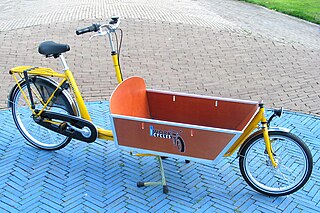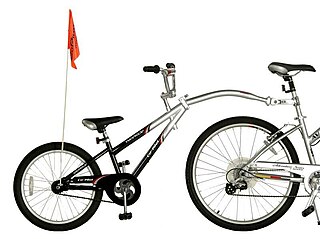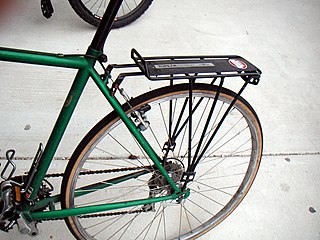
A children's bicycle seat is a saddle that is designed to be put on a bicycle for children to be transported in. The most common place for child bicycle seats are in the rear of the bicycle.

A children's bicycle seat is a saddle that is designed to be put on a bicycle for children to be transported in. The most common place for child bicycle seats are in the rear of the bicycle.

A bicycle, also called a pedal cycle, bike, push-bike or cycle, is a human-powered or motor-assisted, pedal-driven, single-track vehicle, with two wheels attached to a frame, one behind the other. A bicycle rider is called a cyclist, or bicyclist.

Cycling, also known as bicycling or biking, is the activity of riding a bicycle or other type of cycle. It encompasses the use of human-powered vehicles such as balance bikes, unicycles, tricycles, and quadricycles. Cycling is practised around the world for purposes including transport, recreation, exercise, and competitive sport.

A mountain bike (MTB) or mountain bicycle is a bicycle designed for off-road cycling. Mountain bikes share some similarities with other bicycles, but incorporate features designed to enhance durability and performance in rough terrain, which often makes them heavier, more complex and less efficient on smooth surfaces. These typically include a suspension fork, large knobby tires, more durable wheels, more powerful brakes, straight, extra wide handlebars to improve balance and comfort over rough terrain, and wide-ratio gearing optimised for topography, application and a frame with a suspension mechanism for the rear wheel. Rear suspension is ubiquitous in heavier-duty bikes and now common even in lighter bikes. Dropper seat posts can be installed to allow the rider to quickly adjust the seat height.

A tricycle, sometimes abbreviated to trike, is a human-powered three-wheeled vehicle.

A bicycle frame is the main component of a bicycle, onto which wheels and other components are fitted. The modern and most common frame design for an upright bicycle is based on the safety bicycle, and consists of two triangles: a main triangle and a paired rear triangle. This is known as the diamond frame. Frames are required to be strong, stiff and light, which they do by combining different materials and shapes.

There have been many human powered vehicles designed and constructed specifically for transporting loads since their earliest appearance in the 20th century. They are referred to variously depending on the number of wheels — typically two, three, or four — and by their specific use. Adjectives used to describe the tasks to which the bicycles, dicycles, tricycles, or quadracycles are put include cargo cycles, freight cycles, box cycles, carrier cycles, and so on. Sometimes they are also called cycletrucks, which uses a sense of the word 'truck' predating the automobile.

Various methods of transport of children have been used in different cultures and times. These methods include baby carriages, infant car seats, portable bassinets (carrycots), strollers (pushchairs), slings, backpacks, baskets and bicycle carriers.

The Huffy Corporation is a supplier of bicycles with headquarters in Dayton, Ohio, United States.

A bicycle trailer is a motorless wheeled frame with a hitch system for transporting cargo by bicycle. It can greatly increase a bike's cargo capacity, allowing point-to-point haulage of objects up to 3 cubic metres in volume that weigh as much as 500 kg. However, very heavily loaded trailers may pose a danger to the cyclist and others, and the voluntary European standard EN 15918 therefore suggests a maximum load of 60 kg on trailers without brakes.

A bicycle saddle, sometimes called a bicycle seat, is one of five contact points on an upright bicycle, the others being the two pedals and the two handles on the handlebars. The bicycle saddle has been known as such since the bicycle evolved from the draisine, a forerunner of the bicycle. It performs a similar role as a horse's saddle, not bearing all the weight of the rider as the other contact points also take some of the load.
As with many consumer products, early bicycles were purchased solely for their usefulness or fashionableness and discarded as they wore out or were replaced by newer models. Some items were thrown into storage and survived, but many others went to the scrapyard. Decades later, those with an interest in cycling and history began to seek out older bikes, collecting different varieties. Like other forms of collecting, bike collectors can be completists or specialists, and many have extensive holdings in bike parts or literature, in addition to complete bicycles.

A skirt guard, dress guard or coat guard is a device fitted over the rear wheel of a bicycle to prevent a long skirt, coat or other trailing clothes or luggage catching in the wheel, or in the gap between the rim and the brakes.

A balance bike is a bicycle without pedals that learners propel by pushing their feet against the ground. By allowing children to focus on developing their sense of balance and coordination before introducing pedalling, balance bikes enable independent riding more quickly than training wheels.

A trailer bike is a one-wheeled, or sometimes two-wheeled, bicycle trailer designed to carry one or more children in positions that closely resemble that of a bicycle rider. It can be described as the, "back half of a bicycle." The rider of a trailer bike usually has a saddle, handlebars, and pedals. Some fold for more compact storage.

A luggage carrier, also commonly called a (bicycle)rack, is a device attached to a bicycle to which cargo or panniers can be attached. This is popular with utility bicycles and touring bicycles.

A quadracycle is a four-wheeled human-powered land vehicle. It is also referred to as a quadcycle, pedal car or four-wheeled bicycle amongst other terms.

The following outline is provided as an overview of and topical guide to bicycles:

A wheelie bike, also called a dragster, muscle bike, high-riser, spyder bike or banana bike, is a type of stylized children's bicycle designed in the 1960s to resemble a chopper motorcycle and characterized by ape hanger handlebars, a banana seat with sissy bar, and small wheels. Notable examples include the Schwinn Sting-Ray and Krate lines and the Raleigh Chopper line. Other notable manufacturers and retailers that offered models include AMF, CCM, Columbia, Huffy, Iverson, J. C. Penney, Malvern Star, Monark, Murray, Ross, Sears, and Vindec.